Debbie and George, a kind-hearted couple with a passion for fostering animals, never planned on adding another furry member to their household. But fate, it seemed, had other plans. One day, a tiny ball of fluff named Wendy arrived at their doorstep, a stray kitten in desperate need of love and care. 
Despite their initial reservations, Debbie and George couldn’t resist Wendy’s emerald eyes and her pitiful meows. They welcomed her into their home, unsure of how their gentle giant, a 135-pound Great Dane named George, would react to this new addition.
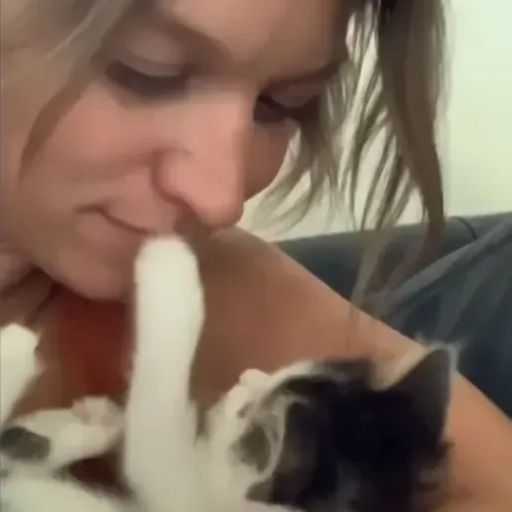
George, with his broad head and soulful brown eyes, was a gentle giant. His playful spirit was often overshadowed by a quiet demeanour, a hint of sadness lingering in his gaze. Debbie suspected it stemmed from the loss of his previous companion, another feline friend who had passed away. George missed his old buddy, and the house felt a little emptier without the playful pitter-patter of paws across the hardwood floors.
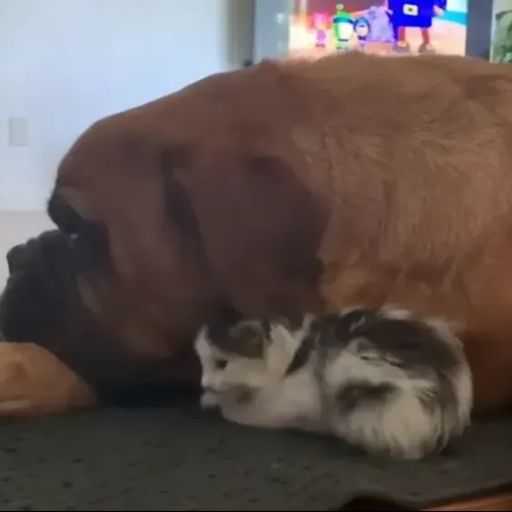
The introduction between George and Wendy was an unexpected delight. Despite the vast size difference, Wendy, a ball of fearless energy, approached George with unbridled curiosity. She sniffed his giant paw, her tiny pink nose twitching inquisitively. George, ever the gentle soul, lowered his head, his long tongue giving Wendy a tentative lick. An unlikely friendship blossomed in that moment, a heartwarming testament to the universal language of love and companionship.

Wendy, unfazed by George’s size, revelled in her newfound freedom. She would scamper across his back, using his broad frame as a personal jungle gym. She’d curl up contentedly beneath his chin, his rumbling snores a lullaby that lulled her to sleep. George, in turn, seemed to relish his new role as protector. He’d follow Wendy cautiously around the house, his giant head swivelling to keep track of her every move. When she’d pause, letting out a playful chirp, George would nudge her gently with his wet nose, a silent promise of companionship.

Debbie and George watched in wonder as their home transformed. Wendy’s playful antics filled the house with laughter, chasing away the lingering shadows of grief. George, once subdued, seemed to come alive again. His tail thumped a happy rhythm against the floor as he playfully chased after the tiny ball of fur that was Wendy. Their bond transcended their physical differences; it was a connection built on trust, affection, and a shared need for companionship.

One afternoon, Debbie found Wendy nestled between George’s paws, fast asleep. George’s rhythmic breathing created a gentle rise and fall of his massive chest, a lullaby for the tiny kitten curled up against him. The sight brought tears to Debbie’s eyes. It was a picture of perfect contentment, a testament to the healing power of love and friendship.
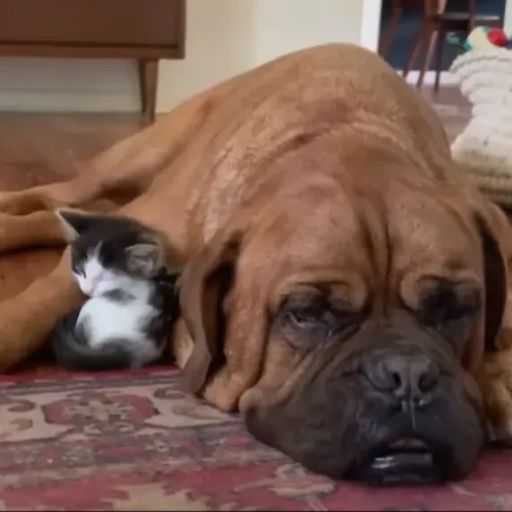
As the days turned into weeks, Wendy blossomed under George’s watchful eye. She grew bigger, stronger, and even more playful. Their bond only strengthened a heartwarming example of an unlikely friendship that defied expectations. George, the gentle giant who had grieved in silence, found solace in caring for the tiny kitten. Wendy, in turn, brought joy and laughter back into his life. They balanced each other out perfectly, a testament to the fact that true friendship can blossom between the most unexpected creatures.
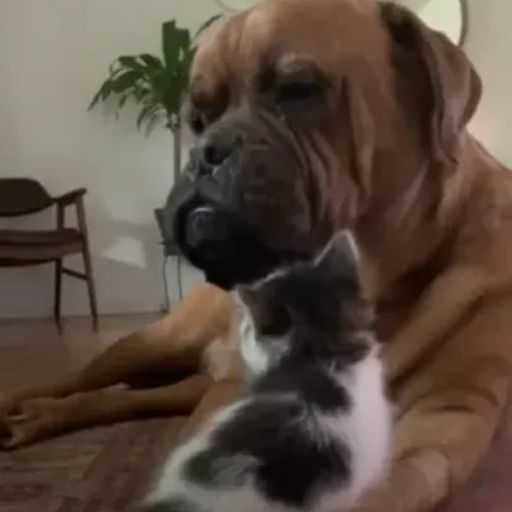
Debbie and George, their hearts overflowing with love for their furry companions, knew they’d made the right decision. Their home, once filled with a quiet emptiness, now echoed with the happy sounds of playful meows and gentle snores. George and Wendy, the unlikely pair, were a constant reminder that love knows no bounds and that sometimes, the greatest friendships come in the smallest packages.
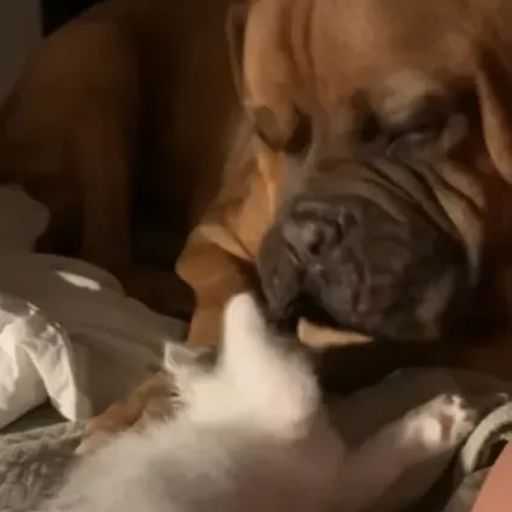
Watch The Full Video Here:
If you’ve ever wondered about the fascinating world of canine biology, the topic of whether dogs get periods might have crossed your mind. As a seasoned dog trainer, you’re well aware of the various behaviors and physical traits that make our furry companions unique. Understanding more about how their bodies function can provide valuable insights into their overall well-being.
As you observe your canine friends frolicking in the park or lounging at home, you may have noticed certain patterns in their behavior. Exploring the topic of dogs and periods can shed light on an aspect of their physiology that influences their daily lives. Stay tuned as we take a closer look at this intriguing subject and unravel the mysteries behind our beloved pets’ reproductive cycles.
Understanding the Canine Menstrual Cycle
Dogs have a different reproductive cycle than humans. Female dogs go through a heat cycle, also known as estrus, instead of menstruation. This cycle occurs about every six to twelve months and can last for about 2-4 weeks.
During the heat cycle, your female dog may show some behavioral changes. She might become more affectionate, restless, or even have a change in appetite. You may also notice some physical signs like vaginal bleeding or swelling.
It’s essential to understand your dog’s heat cycle to prevent unwanted pregnancies. Female dogs are most fertile during the estrus phase, so it’s crucial to keep a close eye on them and possibly separate them from male dogs during this time.
Remember, spaying your female dog is a common practice to prevent heat cycles and reduce the risk of certain reproductive-related health issues. Spaying can also help control the dog population and improve your furry friend’s overall well-being.
Consulting your veterinarian is the best way to get personalized advice on your dog’s reproductive health. They can provide guidance on the best practices for managing your dog’s heat cycles and discuss the option of spaying if it’s suitable for your canine companion.
Signs and Symptoms of Heat in Female Dogs
During your female dog’s heat cycle, you may notice specific signs and symptoms. These indicators can help you identify when your dog is in heat:
- Swollen Vulva: One of the primary signs is a swollen vulva. You may observe that your dog’s genital area appears larger than usual.
- Bloody Discharge: Female dogs in heat often have a bloody discharge. This discharge can vary in color and consistency.
- Frequent Urination: Your dog may urinate more frequently than usual during her heat cycle. This behavior is a common symptom.
- Changes in Behavior: Heat can bring about behavioral changes in female dogs. They may become more restless, anxious, or seek attention.
- Attracting Male Dogs: Female dogs in heat release pheromones that attract male dogs. You may notice more interest from male dogs during this time.
- Flagging: Flagging is when a female dog lifts her tail to one side when approached by a male dog. This behavior indicates receptiveness to mating.
By being aware of these signs and symptoms, you can better understand and care for your female dog during her heat cycle. Remember to consult your veterinarian for personalized advice on managing your dog’s reproductive health.
Differences Between Canine and Human Menstrual Cycles
Understanding the variations between canine and human menstrual cycles is essential. Here are the key differences you should know:
Anatomy:
- Female dogs have an estrous cycle, not a menstrual cycle like humans.
- Dogs experience heat cycles, where they are fertile for breeding, unlike humans who have a monthly period.
Frequency and Duration:
- Canine heat cycles occur every 6-12 months and last around 2-4 weeks, varying from breed to breed.
- Human menstrual cycles typically last around 28 days, with menstruation lasting 3-7 days each month.
Physical Signs:
- Female dogs in heat may show a swollen vulva and bloody discharge, unlike humans who experience menstrual bleeding.
- Dogs may exhibit frequent urination and changes in behavior during heat, while humans may have cramps and mood swings during menstruation.
- Female dogs attract male dogs during heat and may exhibit “flagging” behavior to show they’re ready for mating.
- Humans do not exhibit overt physical signs of receptiveness during menstruation.
Understanding these differences can help you better care for your female dog and manage their reproductive health effectively. Remember, consulting with your veterinarian for personalized advice is crucial for your dog’s well-being.
Spaying and Alternatives
Spaying, or ovariohysterectomy, is a common procedure for preventing heat cycles in female dogs. It involves removing the ovaries and uterus, thus stopping the heat cycle permanently. This surgery is recommended if you don’t intend to breed your dog. It offers various benefits, like reducing the risk of certain illnesses and preventing unwanted pregnancies.
Another option is medical interventions like hormone injections to suppress the heat cycle temporarily. These injections are convenient if you want to delay spaying or breeding your dog. However, they come with potential side effects, so it’s crucial to discuss them with your vet.
If you choose not to spay your dog, you’ll need to manage her heat cycles carefully. Keep her away from intact male dogs to prevent mating, as female dogs in heat can attract males from miles away. Be prepared for behavior changes, like restlessness and increased vocalization, during this time.
Remember, spaying your dog not only helps control her heat cycles but also promotes her overall health and well-being. Consult your veterinarian to decide the best option based on your dog’s breed, age, and lifestyle.
Managing a Female Dog in Heat
Supervising Your Dog
When your female dog is in heat, constant supervision is crucial. You must prevent any unsupervised outdoor time to avoid unexpected mating with male dogs.
Limiting Outdoor Activities
Reduce outdoor activities during your dog’s heat cycle. Limit walks to safe, enclosed areas and avoid public places frequented by other dogs.
Keeping Male Dogs Away
If you have male dogs at home, ensure they are separated from the female in heat. This separation will prevent unwanted mating and potential conflicts.
Providing Comfort
Create a comfortable and secure space for your female dog during her heat cycle. Offer a quiet area with familiar bedding to help her feel safe and relaxed.
Monitoring Behavior Changes
Watch for any unusual behavior changes in your dog during heat. Some dogs may become more agitated, clingy, or anxious. Providing extra comfort and attention can help alleviate stress.
Consulting a Veterinarian
Consulting with a veterinarian is essential during your dog’s heat cycle. They can provide guidance on managing heat, discuss spaying options, and address any concerns you may have.
Conclusion
That’s the lowdown on dogs and their heat cycles. Remember, it’s not like human periods at all. Female dogs go through an estrous cycle, not menstruation. Keep an eye out for the signs to avoid surprises and consider spaying for a more permanent solution. If you’re ever unsure, your vet is your best buddy for advice on what’s best for your furry friend. Stay informed, stay prepared, and give your pup all the love and care during their heat cycle.
Frequently Asked Questions
What is the canine menstrual cycle?
Female dogs go through a heat cycle, not menstruation, occurring every 6-12 months and lasting 2-4 weeks.
Why is it important to recognize behavioral changes during a dog’s heat cycle?
Recognizing behavioral changes is crucial to prevent unwanted pregnancies during this time.
What are the physical signs of a dog in heat?
Physical signs include a swollen vulva, bloody discharge, frequent urination, and changes in behavior.
How does the canine heat cycle differ from the human menstrual cycle?
Female dogs have an estrous cycle, not a menstrual cycle like humans, with distinct frequency, duration, and physical signs.
What is spaying, and why is it a common practice for managing heat cycles?
Spaying is a surgical procedure to remove a female dog’s reproductive organs, providing a permanent solution to prevent heat cycles, reducing health risks and unwanted pregnancies.
Are there alternatives to spaying to manage a dog’s heat cycle?
Hormone injections can be used to temporarily suppress heat cycles as an alternative to spaying.
Why is it important to consult a veterinarian regarding a dog’s heat cycle?
Consulting a veterinarian helps in making informed decisions based on the dog’s breed, age, and lifestyle for overall care during the heat cycle.

Hey there, I’m Janet Brooks, a dog-loving student from California. I’m all about helping pups in need, especially those without homes. Me and my awesome friends work together to give shelter and love to stray dogs. Oh, and I also write blogs about dogs to share helpful info.